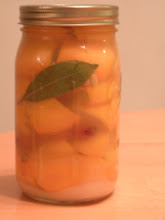Latke Logistics
Hanukkah is just around the corner (first night is December 11 this year). Time to get out those frying pans and start cookin'. I have recipes for 10 different latkes on this website and wanted to be sure to give you all some general advice about latke-making.
Latke, a Definition and a (Very) Brief Hanukkah Story
Why latkes for Hanukkah? Hanukkah is the celebration of the rededication of the Temple after it was destroyed. When the Jews went to rebuild the Temple, they only had enough oil to light the Temple for one days. But, then, a miracle happened, and the oil lasted for eight days until they were able to make more oil to light the Temple. We eat latkes on Hanukkah because they are fried in oil. The oil reminds us of the miracle of the oil and the reason we celebrate Hanukkah.
Why are most latkes made with potatoes? "Latke" is the Yiddish word for "pancake." In Eastern Europe, from where Ashkenazi Jews (and, by default, latkes) hail, our ancestor had lots of potatoes. They made EVERYTHING with them, hence, potato latkes, potato kugel, potato knishes, etc. So, since the reason we eat latkes on Hanukkah is because of the oil, latkes can really be made of anything you can think of. I have 10 different recipes here, feel free to create your own:
Savory
Potato Latkes with Applesauce and Greek Yogurt
Sweet Potato Latkes with Apple Chutney
Southwest Latkes with Creamy Cilantro Dip
Greek Latkes with Tsatsiki Sauce
Zucchini Parmesan Latkes with Marinara Sauce
Thai Noodle Latkes with Spicy Peanut Sauce
Wild Mushroom and Goat Cheese Empanada Latkes with Salsa Verde
Sweet
Apple Pie Latkes with Ice Cream and Caramel Sauce
Bananas Foster Latkes with Rum Sauce
Chocolate Chocolate Chip Latkes with Creme Anglaise
Tips for Great Latkes
1. The real secret to great latkes is to squeeze out as much moisture as possible from the potatoes, spinach or whatever vegetables you are using. The drier, the better. In addition, be sure to squeeze each latke (before adding to the hot oil) between two teaspoons to remove as much moisture as possible.
2. Use a lot of oil. In our health-conscious world this may be counter-intuitive. But, actually, the deeper the oil (as long as it's hot enough, see next tip), the quicker the latkes cook and the LESS OIL THEY ABSORB. It is actually healthier to use MORE oil for frying.
3. Make sure your oil is HOT! To test, stick the handle end of a wooden spoon in the oil all the way down to the bottom of the pan. If small bubbles start to form, the oil is hot enough. Keep in mind that every time you add oil, you need to let it heat up again.
4. Do not over-crowd your pan! Over-crowding cools the oil too much, and the latkes won't cook.
5. The longer your oil is heating (i.e., the longer you're frying latkes), the hotter it gets. While your first few batches may take several minutes on each side to get golden, later batches will take less time because the oil gets hotter the longer it's in the pan over a hot burner.
6. Drain your excess oil. Cut paper grocery bags so you can lay them flat, with the inside touching the latkes. (I line mine on a large baking sheet; it's the perfect size!) As you fill up each layer, add more bags on top and keep stacking layers of latkes between layers of grocery bags. Alternatively, you could use paper towels, but grocery bags absorb more (pound for pound) and why waste more paper when you can just reuse what you already have?
Freezing and Reheating
If you choose to make your latkes ahead of time and freeze them, follow these steps. This a great technique if you are making a lot for a party and don't want to be a slave to the kitchen. Just make sure you have enough room in the freezer!
1. After layering the latkes between grocery bags on a baking sheet, place a grocery bag over the top layer and stick the whole baking sheet in the freezer. Allow to freeze for a few hours or overnight.
2. Remove baking sheet from freezer and place latkes into a zippered freezer bag or other container. Throw away the grocery bags. As far as I can tell, latkes can freeze forever!
3. When ready to reheat, preheat oven to 400 F and line a baking sheet with parchment paper.
4. Place the latkes (directly from the freezer) in a single layer on the parchment paper and bake until heated through. Heating time depends on size and type of latkes you are reheating. Generally, you should start checking after about 10 minutes.
Have a wonderful holiday and happy latke-making!
2009 by Allison Lattman

No comments:
Post a Comment